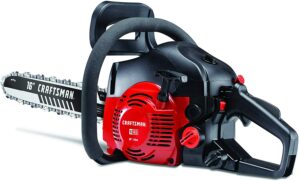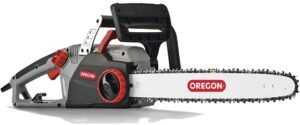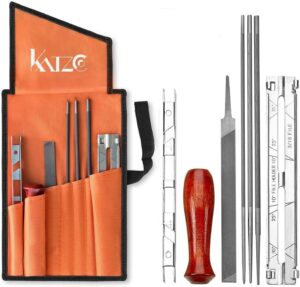Best Chainsaws
Best Gas Powered Chainsaw

Best Electric Chainsaw

Best Chainsaw Accessories

Best Chainsaw Apparel

Choosing the best chainsaw
Electric vs gas
Chainsaws are either electric or gas-powered. There are pros and cons to each, so it typically comes down to personal preference and what you need to use it for. Let’s take a look at the good and the bad of each:
Electric
Most electric chainsaws are lighter and more compact than their gas-powered counterparts, making them easier to carry and use for long durations. They’re also quieter and you can start them with a simple push of a button. Even better, you don’t have to mix oil and gas or inhale the fumes left behind from a gas chainsaw. Electric chainsaws are ideal when tidying up trees and trimming limbs, cutting small logs, and other minor tasks around your home or yard.
Because electric chainsaws are smaller and lighter, most of them lack the umph for larger projects like cutting down large trees. If your chainsaw is corded, you’ll lack the mobility that comes with uncorded electric saws or gas saws. If it’s uncorded, you have more mobility but they tend to be less powerful than corded models — even with battery life improving in recent years with newer, more high-powered batteries.
Gas
A gas chainsaw is much better suited for heavy-duty jobs than an electric model. If you use a chainsaw in your everyday profession or live on a piece of property with a lot of large trees, a gas chainsaw is probably your better option. Gas saws come with a range of bar lengths to adapt to different tasks. You won’t be limited to one area like you would with a corded chainsaw and you won’t run out of battery life like an uncorded electric model, but you will need to make sure you have enough gas and oil.
Gas chainsaws are often heavier and clunkier than electric models, making it more tiresome to use them for extended periods of time. They’re also much louder than electric chainsaws and have a pull-to-start recoil handle that can be tricky for beginners. You have to mix oil and gas to keep it running and those fumes can be dangerous if inhaled too much. Lastly, gas chainsaws typically cost more than electric saws. This price point can be a lot less appealing for someone who is just starting out or only uses a chainsaw periodically.
Chainsaw Components
Once you know whether you want gas or electric, you’ll want to consider the chainsaw’s blades, chain, and engine power.
Blades
Blades are also known as cars, vary in length and hardness, and the right one is highly dependent on the job at hand. For example, solid bars are made from a single piece of steel and are used for the tougher jobs that need that extra strength. You’ll also see hard nose bars (solid through the nose of the blade) and laminated bars (two steel tracks with a steel core and a sprocket between them) that are a little more flexible and will work on smaller tasks.
Chains
Chains come in three variations: narrow kerf, low profile, and ripping chains. Narrow kerf chains are slimmer and allow the saw to cut quickly, making thinner cuts. Low profile chains have shorter cutters than normal to create shallow cuts. Ripping chains cut at a 10° angle, unlike normal cutters that cut at a 30° angle, and are best when cutting smooth boards. Chains also have either semi-chisel or full-chisel — semi-chisel is good for jobs around the house and full-chisel is better for professional use.
Engine power
Power in gas chainsaws is measured in cubic centimeters (cc) while electric chainsaws are measured either in volts (cordless) or amps (corded). This is a good way to gauge whether that model will work for the job you need. You’ll find a variety of power ranges, from 30-120cc for gas-powered and 8-15 amps or 24-82 volts for electric. The higher the power number, the better suited the model is for heavier, more frequent work. For people looking for occasional or light usage around the home, lower power engines will complete the tasks just fine. Professionals will want something in the highest power ranges to ensure the saw can hold up to daily use on a variety of jobs.
Best Gas Powered Chainsaw

This Craftsman gas-powered chainsaw is designed with a 42cc full-crank engine and 16” bar with a low kickback chain for excellent performance on those daily jobs around the home. This model is easy to handle and is lighter in weight than most gas-powered saws without skimping on power. You’ll also love the cushioned handle and anti-vibration system that give added comfort and lessen user-fatigue while operating. The handy adjustable automatic chain oiler maintains the perfect amount of lubricant on the chain and the easy-to-pull crank makes starting up smooth and simple, ensuring your saw is always ready to get to work.
Best Electric Chainsaw

This electric chainsaw by Oregon offers 15 amps of power with an 18” guide bar and is the only corded electric chainsaw on the market with a self-sharpening chain. It has all the usual conveniences of an electric saw — an instant trigger-start, low maintenance, less noise — while taking it one step further with the built-in PowerSharp chain sharpening system. This model is silent between cuts, lightweight and balanced, and offers low vibration to keep you comfortable while in use. You’ll also love the built-in Lubri-Tec oiling system that keeps the chain oiled, giving you minimal chain friction and top performance for all jobs at hand.
Best Chainsaw Accessories

Skip dropping your chain off to be sharpened and get the job done at home with the help of the Katzco chainsaw file kit. It comes with every field tool you’ll need to get your chainsaw back to ready-to-use condition. The wide range of different files will work on any chainsaw and answer every sharpening need. Each file is made with a sturdy wood handle to give you a comfortable grip and allow you to work faster and safer. The roll-up carry pouch keeps everything organized and conveniently together and is easy to bring with you wherever and whenever you may need it.
Best Chainsaw Apparel

Don’t get started using your chainsaw without the protection from these Forester chainsaw chaps. This protective leg garment is designed to reduce the risk of injury from a gas-powered saw to the body parts covered by the padding. They meet the protection requirements for both OSHA and ASTM leg protection safety standards. These chaps are comfortable and lightweight with an adjustable waistband to fit waists between 28-46”. From the 1200 denier water and oil resistant outer to the multi-layer protection inner, you can be sure you’re receiving the highest level of protection when handling your chainsaw.
*NOTE: These chaps are not designed to protect against electric chainsaws due to the high-torque nature of electric motors.
FAQs about Chainsaws
What is kickback?
In layman’s terms, kickback describes the unexpected upward motion of the guide bar on a chainsaw, usually due to the nose of the bar striking a solid object and causing the chain to snag or pinch. In some cases, it can cause the blade to fly back in the opposite direction toward the operator and lead to injury. The greater the force of the kickback, the harder it is for the operator to control. The force of the kickback depends on a couple different factors, including chain speed, the angle of contract, the condition of the chain, and the speed at which the chainsaw makes contact with the solid object.
How often should I sharpen my chainsaw chain? And how long will the chain last?
There isn’t a one-size-fits-all answer for when you have to sharpen your chain. The best way to tell is by being aware of how your chain is cutting when you use it. If you notice the saw isn’t cutting as well as before, or if you’ve hit something solid, it’s time to sharpen the chain. Always check the condition of the chain after you use it to see if it’s gotten dull or if any teeth are missing.
Chains can be sharpened up to 10 times or more before it needs replacing.
What protective gear is needed when operating a chainsaw?
Safety is key when you use a chainsaw. Here are a few things to keep in mind when it comes to what kind of gear to use for protection during use:
- Clothing must be snug-fitting and sturdy while allowing freedom of movement. Overalls or special cut-resistant chaps can be worn for extra protection. Avoid loose-fitting tops, scarves, jewelry, baggy or flared pants, unkempt long hair, or anything else that could get tangled in the saw.
- Heavy-duty, nonslip gloves will improve your grip and protect your hands while using a chainsaw or handling a blade.
- Wear sturdy boots with nonslip soles to stay grounded while sawing. Steel-toed safety boots are ideal.
- Wearing goggles or properly fitted safety glasses with both top and side protection will protect your eyes and face from flying or spraying debris from the chain.
- Wear an approved safety hard hat to protect your head and ear plugs or mufflers to protect your ears. (Someone who uses chainsaws frequently should also have their hearing checked regularly.)

